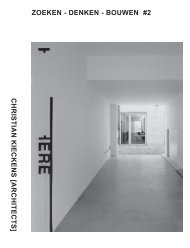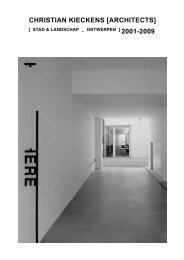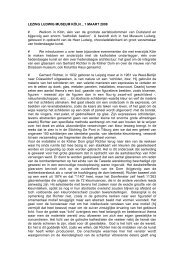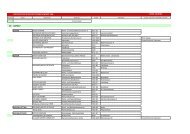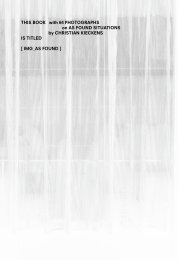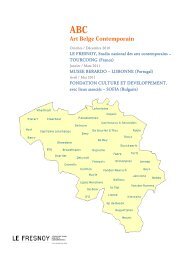download pdf - Christian Kieckens Architects
download pdf - Christian Kieckens Architects
download pdf - Christian Kieckens Architects
You also want an ePaper? Increase the reach of your titles
YUMPU automatically turns print PDFs into web optimized ePapers that Google loves.
Stefano MUSSO<br />
Mathieu WELLNER<br />
_ Stefano F. MUSSO, architect Phd., Full Professor of Architectural<br />
Restoration, Vice-Dean of the Faculty of Architecture, Director of the<br />
Specialization School for Architectural Heritage and Landscape of the<br />
University of Genoa [Italy], President of the Bachelor course in<br />
Architectural Restoration. He teaches as well Restoration at the Faculty<br />
of Engineering and he is member of the Academic Senate of the University<br />
of Genoa. Member of the Committee of the Ph.D. course in Building and<br />
Environmental Recovery, Secretary of the Scientific Committee of ANCSA<br />
[National Association of Historical Artistic Centres], member of the EAAE<br />
Council [European Association for Architectural Education]. Member of the<br />
“DO.CO.MO.MO. Italia” Council and of the Scientific Board for the<br />
“Sciences and Cultural Heritage” Congresses of Brixen.<br />
_ °1972, Paris. He received his diploma in Architecture in Brussels. Moved to<br />
Munich where he started to work on several projects, exhibitions and publications.<br />
He joined the Faculty of Architecture of the Technische Universität München in<br />
2007. Since 2006, he has been working as the coordinator of architectural projects<br />
for the Haus der Kunst. Currently curating, lecturing and teaching. In 2009 he will<br />
receive his PhD on “Dialogues” in Graz [Austria].<br />
Restoration of ancient buildings in<br />
Liguria and Piedmont:<br />
between Conservation and New Architecture<br />
Since more than two centuries, European culture has been discussing<br />
about the destiny of several monuments fortunately still existing in our cities<br />
and landscapes. They are the fragments of a precious material and spiritual<br />
legacy, the irreplaceable traces of an ancient and sometimes unknown,<br />
or forgotten history. They represent something to be transmitted to future<br />
generations as the most important signs of our cultural and social identity<br />
(or specificity). Our monuments (ancient or recent), in fact, are not “mere<br />
buildings”, they are more important than simple products of our ancestors’<br />
constructive capability and for this reason we have to save them. Within this<br />
perspective, we need clear concepts and affective technical tools, as the<br />
two examples the lecture will deal about, try to show.<br />
Put your city on the map<br />
It is an obvious truth that “images transport meanings” - “say more than<br />
1000 words”; especially in a world where the packaging is more important<br />
than its content. “Unique-selling-point”-concepts and -designs [iconic<br />
buildings] as well as distinctive brandings seem to be the requirement for<br />
an international place on the map. It however becomes very interesting<br />
when these strategies fall flat or when an image transforms and gets new<br />
meanings.<br />
24<br />
25



